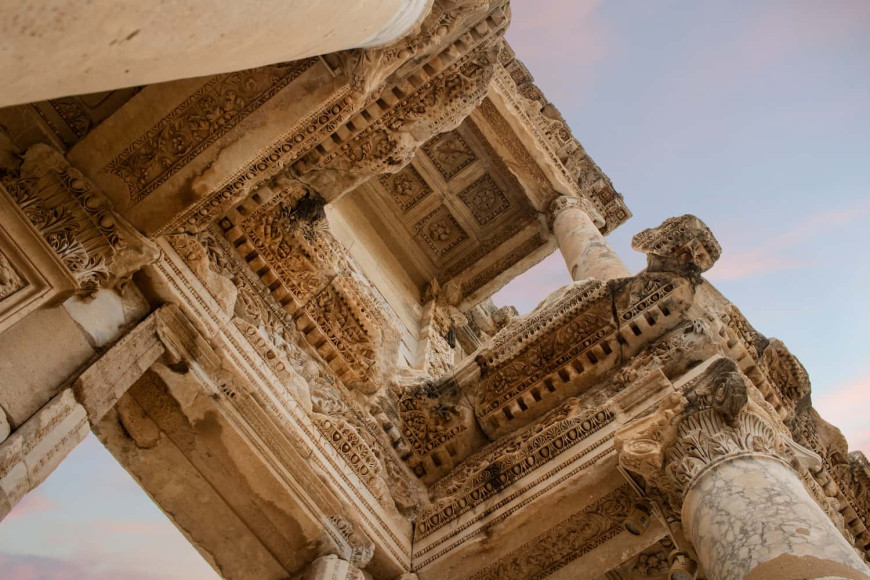Throughout the years, Turkish architecture represented a unique legacy that Turkey celebrated. Architectural buildings are visited by tens of millions of foreign visitors annually to see these invaluable legacies. Turkey has hosted many cultures throughout history. It was a bridge between Europe and Asia and that reflects its strategic area between both continents, every region in Turkey is unique when compared to the rest of the areas. All this richness and cultural diversity has led to the development of concepts of lifestyle, architecture, and art.
The features of Seljuk architecture in Turkey began to occur in the period of the migration of Turkish tribes to the regions of Anatolia and laying the foundation of the Ottoman Empire, and were characterized by mosques, colleges, domes, and Turkish baths. The different cultural conditions that the Ottoman Empire embraced were reflected in the architectural structures, motifs, and carvings that decorate the buildings, palaces, and houses. Among the motifs, carvings, and windows that executed light, and the exploitation of the smallest voids on the walls and ceilings, architecture in Turkey has presented the most beautiful artifacts representing different times throughout history.
Seljuk Architecture in Turkey
Turks were nomadic people who changed their dome-shaped tents to fit their conditions in their native Central Asia. Later, these tents had an influence on Turkish decorative arts and architecture in Turkey. When the Seljuk Turks first came to Iran, they saw buildings that had been built using traditional techniques. A particular architectural trend began when the Seljuk kingdom reached Turkey. Despite the variety of its cultural effects, the empire did a great job adapting the architectural elements to the Turkish region.
Numerous structures were built during this period, involving tombs, mosques, medreses, hospitals, palaces, baths, and others. These architectural structures are distinguished due to their uncomplicated formwork, simple design, and pleasing proportions. These architectural buildings were mainly straightforward but contained the idea of a Monumental Portal, an entryway embellished with striking, ornate adornment. Large, exquisitely polished stone and brick blocks were used in Seljuk architecture in Turkey, which is often referred to as “Poetry in Stone.” The Çifte Minareli Medrese in the province of Erzurum is an exquisite example of the style.
Ottoman Architecture in Turkey
The Ottoman Empire excelled at many things including constructing landmark buildings that instantly captured the eye and earned untold admiration. Many other techniques including Islamic and Byzantine architecture affected them however, they went on to form the distinctive look that earned them a permanent place in architectural history books.
Ottoman architecture in Turkey, some of their best masterpieces still standing today include palaces, water fountains, and bridges. However, its admiration focuses more on their mosques with intricate designs most befitting a place of worship. Although their reputation for excellent architecture began in the 14th century, when they were dominating rulers of Bursa and Edirne, it was to be many years before they constructed the buildings that still stand the test of time even now. The best location to see Ottoman architecture in Turkey is the old district of Istanbul, holding the SultanAhmet Blue Mosque as well as Topkapi Palace, their first region when they invaded Constantinople.

Example of Architecture in Turkey: Hagia Sophia
The well-known Hagia Sophia structure was constructed in 537 AD by Roman Emperor Justinian I and served as the largest cathedral during that bygone era. The Hagia Sophia features marvelous Byzantine architecture in Turkey with a beautifully crafted dome and some of the most amazing ancient mosaics you will ever see. The Hagia Sophia was converted to a mosque in the 15th century by the Ottoman Empire which conquered Constantinople. The minarets were added to the structure during this duration and the panes of Islamic calligraphy are jaw-dropping. Finally, the Hagia Sophia was transformed into a museum in 1935 and is today an attraction in Istanbul you simply cannot miss. You can easily visit the Hagia Sophia by hopping onto the Metro that will take you to Sultanahmet Station which is a short walking distance in Istanbul.
Modern Architecture in Turkey
Turkey has become a global cultural epicenter in the world. Combining a diverse and rich history with new development, this country is known for its eclectic and historic techniques situated side-by-side. Home to one of the fastest growing metropolitan economies in the world in Istanbul, new modern architectural structures are being built across the country. Going beyond orthogonal and pragmatic designs, these buildings are made with novel building envelopes, open public spaces, and diverse relationships to the landscape.
For instance, the Antalya Aquarium in Turkey was constructed to be in harmony with its surrounding landscape. Combining a public area with an interior program, the design contains a wavy, curvaceous shell that helps protect it from the wind. The Antalya Aquarium design process was centered on constructing a vanishing silhouette and harmony with the surrounding topography. At the back of the ground floor, a shaded public space was constructed to protect visitors from the wind and allow them to enjoy the sun. According to modern architecture in Turkey, this zone is a point of approach, gathering, and diffusion for the project.
Example of Modern Architecture in Turkey: The Farm Of 38° 30°
The Farm of 38° 30° is a quintessential boutique dairy factory in Turkey whose monumental form follows a contemporary approach. Wonder how it got its extraordinary name? Being located in the village of Afyon Tazlar, its coordinates of “38° 30° Valley of Art” were the driving power behind this name. Rather than simply being a production space this fascinating building also maneuvers as a cheese showroom and a museum. Based on modern architectural understanding, in an ellipse enclosing an enclosed courtyard, the structure encompasses the sequential production mechanism and spaces, thereby allowing the visitors to observe the production of cheese through the transparent facade in a unique 360° inviting environment.
Glocalization Architecture in Turkey with New Age
Famous architecture in Turkey is much, much older than all the stops you visited historically. These architectural styles are the expression of a long process, the effort and touch of human beings to build their environment together with their existence. The struggle to protect nature from the physical conditions, the search for a safe place, and then the development of materials and science, all these structures, from simple needs to splendor, from functionality to aesthetics, from saving the day to witnessing history, have also turned into a form of expression of individuals, societies and the geographies they belong to. The real estate market shows excellent investment and property opportunities in Turkey. If you want to become a property in Turkey, we, as Tolerance Home, will be very happy to help you.
Tolerance Homes
We are always ready to answer all your questions, please reach out via Whatsapp +90 (532) 158 42 44
If you want to emigrate or buy an apartment in Turkey or own a property in turkey and enjoy life by the sea, message our specialists who will find the best options for your budget.
Also, subscribe to our YouTube channel and Instagram page to receive information from the professionals!
An additional channel to connect with us: Telegram


